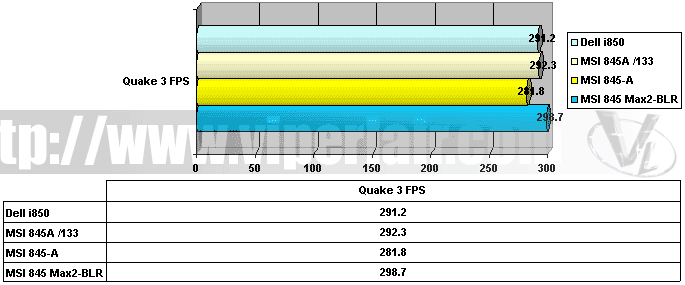|
3D Mark 2001SE
Click for Online Result Browser
3D Mark is one of those benchmark apps that will eat up as much processing power as it can. Benchmarks were run at default 1024x768, as I felt 640x480 is getting to be fairly pointless. The Max2-BLR easily pulls away from the 400FSB based boards, demonstrating that in fact, FSB is king. The overclocked 845-A comes close again, but still falls behind the 845E.
Quake 3 Arena

It's getting old, I know, but Quake 3 is still a decent benchmark for almost anything. For motherboards and CPUs, we run at the lowest settings and fire away. It's begining to sound like a broken record, but the faster 845E wins again. It's interesting to note that the RDRAM system is faster than the stock DDR setup, since their FSB speeds are equal.
Jedi Knight 2

Jedi Knight is still a Quake 3 engine game, but heavily modified. It's extemely taxing, but like Quake 3, the 845E scores another victory.
Final Words
The MSI 845E Max2-BLR packs a lot of features that make it a unique entry in the growing Pentium 4 motherboard crowd. The Bluetooth addition is a feature that many home, or mobile users may find very useful. Bluetooth is more than just networking, and it's features make it very attractive for many.
Other than that, enthusiasts will like the overclockability, stability, and generally good speed. The addition of the heatsinks on the mosfets are a nice touch, and the red PCB returns, making the board very attractive for case window equipped cases.
This board is faster than the previous 845 DDR (845D) board MSI released, even when overclocking the earlier board to 533FSB. My guess is that Intel did a little tweaking to the i845E.
The onboard LAN and sound were nice touches. Both will hit your CPU while in use, but nothing too terrible. We lost about 6 FPS in Quake 3 when using the onboard sound, and about 7 FPS while downloading a map pack during benchmarking. This is hardly a problem if you're averaging 190+ FPS.
I want to be careful when I mention this, since I didn't invest too much time into it, but the Promise controller, which was identical to the one found in the KT3 Ultra-ARU, actually benchmarked significantly faster on the Max2-BLR. In PC Mark 2002, hardly a standard disk benchmark but I'm mentioning our results here, the KT3 Ultra scored 967. With the Max2-BLR, we scored 1334. Why the difference? I'm not really sure, as the hard drives, and RAID controller were identical. I've read reports of the VIA/Promise issues, but please research more on this topic if this is of concern to you.
There are a few downsides to the board, though not necessarily MSI's fault. The DIMM issues, where only two banks at any time can be populated with double-sided DIMMs, might be a problem for those of you who stockpiled a ton of ram. The lack of PC2700 support was sorely missed, as even the original 845D kept pace with the newer 845E. Finally, the price may be a little high for some people, ringing in at about 297$ for all the accessories, whereas the Max2-LR (no Bluetooth) is quite a bit cheaper at 135$. All these prices we got from .
That being said, we were very impressed with the performance and the overall packaging. The board was remarkably stable during testing, only faltering when we pushed it too hard. They include a nice group of software utilities for the users, and a lot of extra accessories, that even despite the relatively high price, is probably cheaper than if you were to buy them separately.
MSI:
Pros: Good performance, extra USB 2.0 ports, solid construction, stable, good software bundle, Bluetooth.
Cons: Long boot times with RAID enabled, lack of PC2700 support.
Bottom Line: As with most recent boards, feature-wise, MSI does not skimp here. Memory speed could have been better had Intel built PC2700 support, but the jump to 533FSB certainly helped the CPU scores. Given the choice of an older 845D, or a more expensive i850 setup, I think I know which I'd rather have...
Agree? Disagree? Discuss it in our forums.
Previous Page - Benchmarks
Home
|
